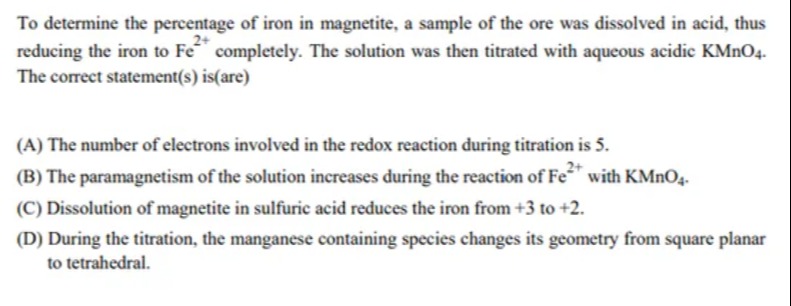Question
Question: To determine the percentage of iron in magnetite, a sample of the ore was dissolved in acid, thus re...
To determine the percentage of iron in magnetite, a sample of the ore was dissolved in acid, thus reducing the iron to Fe2+ completely. The solution was then titrated with aqueous acidic KMnO4. The correct statement(s) is (are)

The number of electrons involved in the redox reaction during titration is 5.
The paramagnetism of the solution increases during the reaction of Fe2+ with KMnO4.
Dissolution of magnetite in sulfuric acid reduces the iron from +3 to +2.
During the titration, the manganese containing species changes its geometry from square planar to tetrahedral.
(A), (B)
Solution
The question asks for the correct statement(s) regarding the process of determining the percentage of iron in magnetite (Fe3O4) by titration with acidic KMnO4. The process involves dissolving the ore in acid and ensuring all iron is in the Fe2+ state, followed by titration with KMnO4.
Let's analyze each statement:
(A) The number of electrons involved in the redox reaction during titration is 5.
The titration reaction involves the oxidation of Fe2+ to Fe3+ and the reduction of MnO4− to Mn2+ in acidic solution.
The oxidation half-reaction is: Fe2+→Fe3++e−
The reduction half-reaction is: MnO4−+8H++5e−→Mn2++4H2O
To balance the electrons, we multiply the oxidation half-reaction by 5:
5Fe2+→5Fe3++5e−
Now, add the two half-reactions:
MnO4−+8H++5Fe2+→Mn2++5Fe3++4H2O
In this balanced reaction, 5 electrons are transferred from 5Fe2+ ions to one MnO4− ion. The number of electrons involved in the redox reaction (per mole of MnO4− or per 5 moles of Fe2+) is 5.
Thus, statement (A) is correct.
(B) The paramagnetism of the solution increases during the reaction of Fe2+ with KMnO4.
Paramagnetism is due to the presence of unpaired electrons. We need to consider the number of unpaired electrons in the relevant species: Fe2+, Fe3+, MnO4−, and Mn2+.
Electron configuration of Fe: [Ar]3d64s2.
Fe2+: [Ar]3d6. In aqueous solution (high spin), it has 4 unpaired electrons (t2g4eg2).
Fe3+: [Ar]3d5. In aqueous solution (high spin), it has 5 unpaired electrons (t2g3eg2).
Electron configuration of Mn: [Ar]3d54s2.
MnO4−: Mn is in +7 oxidation state, [Ar]3d0. It has 0 unpaired electrons and is diamagnetic.
Mn2+: [Ar]3d5. In aqueous solution (high spin), it has 5 unpaired electrons (t2g3eg2).
The reaction consumes Fe2+ (4 unpaired electrons) and MnO4− (0 unpaired electrons) and produces Fe3+ (5 unpaired electrons) and Mn2+ (5 unpaired electrons).
Consider the change in the number of unpaired electrons for the stoichiometric reaction unit:
5Fe2++MnO4−→5Fe3++Mn2+
Initial state (reactants): 5×(unpaired e− in Fe2+)+1×(unpaired e− in MnO4−)=5×4+1×0=20 unpaired electrons.
Final state (products): 5×(unpaired e− in Fe3+)+1×(unpaired e− in Mn2+)=5×5+1×5=25+5=30 unpaired electrons.
As the reaction proceeds, species with fewer unpaired electrons (Fe2+ and MnO4−) are replaced by species with more unpaired electrons (Fe3+ and Mn2+). The total number of unpaired electrons in the solution increases. Since paramagnetism is proportional to the number of unpaired electrons, the paramagnetism of the solution increases during the reaction.
Thus, statement (B) is correct.
(C) Dissolution of magnetite in sulfuric acid reduces the iron from +3 to +2.
Magnetite (Fe3O4) is a mixed oxide containing both Fe2+ and Fe3+ ions in a 1:2 ratio (FeO⋅Fe2O3). When magnetite dissolves in a non-reducing acid like sulfuric acid, the ions are simply released into solution:
Fe3O4(s)+4H2SO4(aq)→FeSO4(aq)+Fe2(SO4)3(aq)+4H2O(l)
or in ionic form:
Fe3O4(s)+8H+(aq)→Fe2+(aq)+2Fe3+(aq)+4H2O(l)
Dissolution in sulfuric acid itself does not reduce the Fe3+ ions present in magnetite to Fe2+. The problem states that the ore was dissolved in acid, "thus reducing the iron to Fe2+ completely". This implies that a reduction step was performed, but dissolution in sulfuric acid alone does not achieve this reduction. A separate reducing agent would be required to convert all Fe3+ (both original and from dissolution) to Fe2+.
Thus, statement (C) is incorrect.
(D) During the titration, the manganese containing species changes its geometry from square planar to tetrahedral.
The manganese containing species involved are MnO4− and Mn2+.
MnO4− (permanganate ion): Mn is in +7 oxidation state. It is bonded to four oxygen atoms. The structure is tetrahedral (Tétrahedral geometry, like sulfate or phosphate ions).
Mn2+ (manganese(II) ion): In aqueous solution, Mn2+ ions are hydrated, forming complex ions like [Mn(H2O)6]2+. These hydrated metal ions typically have octahedral geometry.
The statement claims the geometry changes from square planar to tetrahedral. This is incorrect. MnO4− is tetrahedral, not square planar. Mn2+ is octahedral (when hydrated), not tetrahedral.
Thus, statement (D) is incorrect.
Based on the analysis, statements (A) and (B) are correct.
